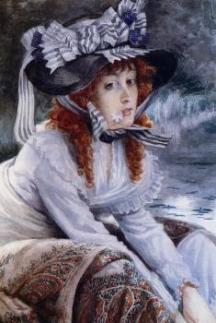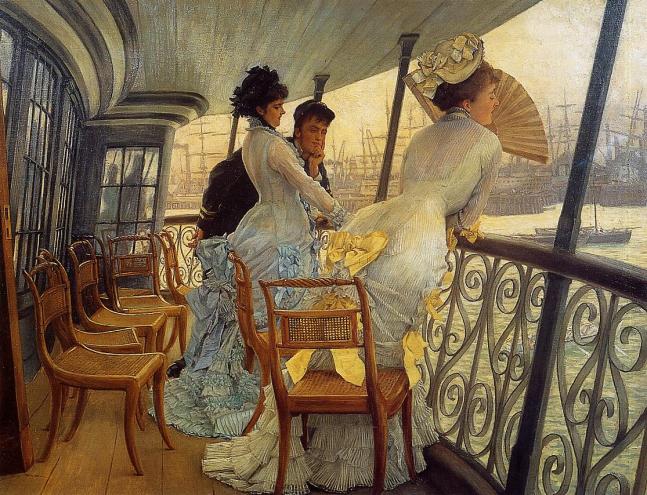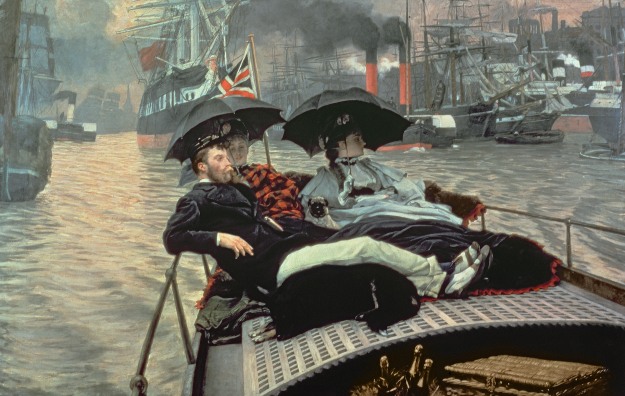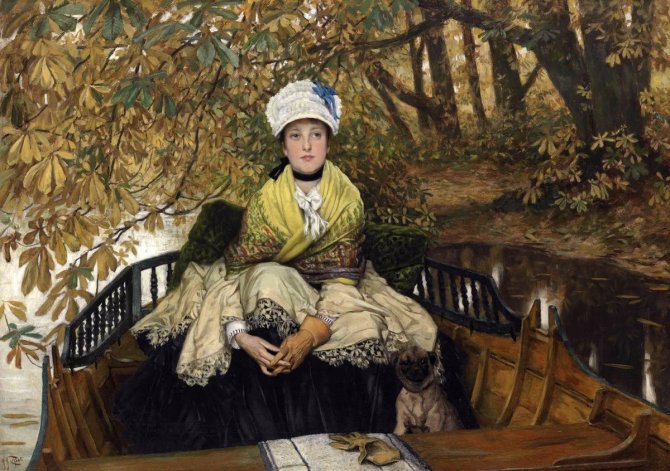To cite this article: Paquette, Lucy. “Girls to Float Your Boat, by James Tissot.” The Hammock. https://thehammocknovel.wordpress.com/2014/06/15/girls-to-float-your-boat-by-james-tissot/. <Date viewed.>
All prices listed are for general reader interest only, and are shown in this order: $ (USD)/£ (GBP). All prices listed are Hammer Price (the winning bid amount) unless noted as Premium, indicating that the figure quoted includes the Buyer’s Premium of an additional percentage charged by the auction house, as well as taxes.
 Recently, I had the opportunity to steer a schooner out toward the Chesapeake Bay Bridge. It was a perfect day with a lively cool wind, the bay was a sparkling blue, and the experience was pure water and sky. I should have applied more sunscreen, since I found myself with a bit of sunburn when the cruise ended back at Annapolis, Maryland.
Recently, I had the opportunity to steer a schooner out toward the Chesapeake Bay Bridge. It was a perfect day with a lively cool wind, the bay was a sparkling blue, and the experience was pure water and sky. I should have applied more sunscreen, since I found myself with a bit of sunburn when the cruise ended back at Annapolis, Maryland.
James Tissot, raised in the seaport of Nantes, France, painted boats and ships in paintings such as Le Départ de l’enfant prodigue à Venise (c. 1863) from the early years of his career.
Often, these canvases have no sense of movement and lack air – clearly, many of his scenes were composed inside his elegant studio in Paris (in which he painted from early 1868 through at least the outbreak of the Franco-Prussian War in 1870) and from 1875 to 1882, in the luxurious studio he constructed at his home at 17 (now 44) Grove End Road in St. John’s Wood, London.
But his images of beautiful women on the river and the sea are charming, imbued with nautical insight and a sense of seafaring delight even in those that are, really, costume pieces. Others were a little naughty, and some were even controversial.

Jeune femme en bateau (Young Woman in a Boat, 1870), by James Tissot. (Photo: Wikimedia.org)
Tissot painted several versions of Young Woman in a Boat (1870) from his studio in the avenue de l’Impératrice (now avenue Foch) in Paris. One, oil on panel measuring 13 by 9 in. (33.02 by 22.86 cm) was sold in 1979 at Sotheby’s, Belgravia for $ 862/£ 380. In 1985, an oil on canvas measuring 20 by 26 in. (50.80 by 66.04 cm) sold at Sotheby’s, London for $ 402,721/£ 310,000; this version was displayed at the Salon in 1870, one of Tissot’s final two oils exhibited in Paris prior to the outbreak of the Franco-Prussian War later that year. Another version of Young Woman in a Boat, oil on paper measuring just 5 by 7 in. (12.70 by 17.78 cm), was sold in 1995 at Sotheby’s, London for $ 8,769/£ 5,500.
People often observe that Tissot’s women are languid, superficial creatures, but when this painting appeared in England, a critic there commented that the woman looked angry and impatient at being kept waiting by her lover. If this was Tissot’s intent (and he deftly defied such easy interpretations), then this woman, with her frank gaze at the viewer, is a rare breed in Victorian painting: the fully developed, adult female. But of course, she is not an authentic, contemporary woman. Her feminine annoyance is permissible in the guise of a costumed anecdote from the French Directory period, 1795 – 1799. Imagine an exasperated adult woman dressed in the latest fashion looking frankly at a male viewer from the wall of the Salon or the Royal Academy in 1870!

On the River (c. 1871, watercolor), by James Tissot. 13 by 9 in. (33.02 by 22.86 cm). Private Collection. (Photo by Wikipaintings.org)


On the River (1871), by James Tissot. (the_athenaeum.org)
On the River (1871), measuring 34 by 19 in. (86.36 by 48.26 cm), was in the collection of Mrs. M. Ford until it was sold at Sotheby’s, London for $ 1,175/£ 420 in 1964. It was purchased by Jeremy Maas, a London art dealer who sold it to the U.K. Department of the Environment in July, 1973. As part of the Government Art Collection, On the River is now at the British Embassy in Paris.
Another oil version of On the River (1876), measuring 33 by 19 in. (83.82 by 48.26 cm) sold at Sotheby’s, London in 1959 for $ 615/£ 220. As Lady on the river, this version sold at the same auction house in 1972 for $ 7,290/£ 3,100.
The watercolor version of On the River (c. 1871), shown to the left, was sold at Sotheby’s, New York in 1988 for $ 100,000/£ 56,557. In 1991, it sold at the same auction house for $ 70,000/£ 40,935.

On the Thames, A Heron (c. 1871-72), by James Tissot. 36 1/2 by 23 3/4 in. (92.71 by 60.33 cm). Minneapolis Institute of Arts, Minnesota, U.S. (Photo: Wikimedia.org)
James Tissot fled Paris following the Franco-Prussian War and its bloody aftermath, the Commune. [To read about Paris in June, 1871, click here.] On the Thames, A Heron (c. 1871-1872) is one of Tissot’s first paintings after his arrival in London – and it was the first on record to be sold at auction in England. Calculated to appeal to Victorian tastes, this Japanese-influenced scene was owned by wealthy Spanish banker José de Murrieta. Murrieta tried to sell the painting on May 24, 1873 as On the Thames: the frightened heron; priced at 570 guineas, it did not find a buyer. His brother, Antonio de Murrieta, attempted and failed to sell it on June 15, 1873 for 260 guineas. As The Heron, the painting was sold at Sotheby’s, New York in 1973 for $ 32,000/£ 12,886. On the Thames, A Heron was the gift of collector Mrs. Patrick Butler, by exchange in 1975, to the Minneapolis Institute of Arts and is displayed in Gallery G357. For an interactive view of it, click here.

Autumn on the Thames, Nuneham Courtney (c. 1871-72), by James Tissot. Oil on panel, 29 by 19 in. (73.66 by 48.26 cm). Private Collection. (Photo: Wikipaintings.org)
Autumn on the Thames, Nuneham Courtney (c. 1871-72), was sold at Sotheby’s, New York in 1984 for $ 200,000/£ 167,855. Nine and a half years later, in 1994, it again was sold at Sotheby’s, New York, this time for $ 425,000/£ 281,270. Nuneham Courtney, near Oxford, was a popular destination for picnics after a row or punt up the Thames. Art historian Nancy Rose Marshall points out that this picture was more likely painted between 1874 and 1876, when Tissot used the same blonde model in the foreground for Quarrelling.

The Return from the Boating Trip (1873), by James Tissot. Oil on panel, 24 by 17 in. (60.96 by 43.18 cm). Private Collection. (Photo: Wikipaintings.org)

Still on Top, by James Tissot. (Photo: Wikipaintings.org)
The Return from the Boating Trip (1873) was sold at Christie’s, London in 1982 for $ 31,852/£ 20,000.
Note that Tissot used the same the male model in Autumn on the Thames, Nuneham Courtney.
Tissot used the woman’s striped gown again in Boarding the Yacht (1873, Private Collection) and The Captain and the Mate (1873, Private Collection), as well as in Still on Top (c. 1874, Auckland Art Gallery Toi o Tāmaki, New Zealand) and Preparing for the Gala (Private Collection).
Tissot used the dress yet again in Portsmouth Dockyard (also known as Entre les deux mon coeur balance, or How Happy I Could Be with Either, c. 1877, Tate Britain, London). Exhibited at the Grosvenor Gallery from May to June 1877, Portsmouth Dockyard depicts an officer wearing the uniform of the 42nd Royal Highland regiment, known as the “Black Watch.” The picture was well-received, which was Tissot’s intention after the harsh criticism of The Thames the previous year at the Royal Academy exhibition in 1876 (see below); the Times art critic described Portsmouth Dockyard as a painting in which “a happy Highland sergeant finds himself to his huge content afloat in company with two sprightly ladies.” Novelist Sir Hugh Walpole (1884 – 1941), an art collector, bequeathed Portsmouth Dockyard to the Tate in 1941. It is not on display.

Portsmouth Dockyard (also known as Entre les deux mon coeur balance, or How Happy I Could Be with Either, c. 1877) c. 1877) by James Tissot. Oil on canvas, 15 by 21 1/2 in. (38 by 54.5 cm). Tate, London. (Photo: Wikipaintings.org)

Sur la Tamise (or Return from Henley, also known as On the Thames, c. 1874), by James Tissot. Oil on canvas, 57.48 by 40.04 in. (146.00 by 101.70 cm). Private Collection. (Photo: Wikipaintings.org)
Sur La Tamise (Return from Henley), c. 1874, was sold as On the Thames by one private American collector to another, in 1916. It was acquired by physician, art collector and philanthropist Dr. J. Ackerman Coles (1843 –1925), of Scotch Plains, New Jersey and was donated to The Newark Museum, in Newark, New Jersey in 1926, the year after his death. Dr. Coles was a direct descendant of James Cole, a Puritan who arrived at Plymouth, Massachusetts, between 1620 and 1630, and his collection forms the cornerstone of the Newark Museum’s renowned holdings of nineteenth-century American art. However, The Newark Museum deaccessioned Tissot’s painting in 1985, when it was sold at Sotheby’s, New York, to a private collector for $ 370,000/£ 293,860. In 2011, it was estimated to sell for $ 1,500,000 – 2,500,000 USD at Sotheby’s, New York, but it did not find a buyer at that time.

The Ball on Shipboard (c. 1874), by James Tissot. Oil on canvas, 33 1/8 by 51 in. (84 by 130 cm). Tate, London. (Photo: Wikimedia.org)
Tissot exhibited The Ball on Shipboard at the Royal Academy in London from May through August 1874, three years after he had left Paris in the aftermath of the Franco-Prussian War. Reviewers (but interestingly, not Tissot himself) identified the setting as the yearly regatta at Cowes, on the Isle of Wight. Tissot assured Berthe Morisot, who was at Cowes during regatta week the following year while on her honeymoon with Édouard Manet’s brother, Eugène, that they saw the most fashionable society in England. But one critic of The Ball on Shipboard wrote, “The girls who are spread about in every attitude are evidently the ‘high life below stairs’ of the port, who have borrowed their mistresses’ dresses for the nonce,” and another objected to the unseemly amount of cleavage revealed by the women wearing the blue and green day dresses (left of center). Another critic found in the picture, “no pretty women, but a set of showy rather than elegant costumes, some few graceful, but more ungraceful attitudes, and not a lady in a score of female figures.” Yet another found it “garish and almost repellent.” Regardless, London art dealer Thomas Agnew – who specialized in “high-class modern paintings” – purchased The Ball on Shipboard from Tissot that year and sold it to Hilton Philipson (1834 – 1904), a solicitor and colliery owner living at Tynemouth. (Philipson also spent 620 guineas at Agnew’s for John Everett Millais’ 1874 painting, The Picture of Health, a portrait of Millais’ daughter, Alice (later Mrs. Charles Stuart Wortley).
The Ball on Shipboard later belonged to Philipson’s son’s widow, Mrs. Roland Philipson (c. 1866 – 1945), then the Leicester Galleries, London, and by 1937, to Alfred Munnings (1878 – 1959), a self-taught equine painter who loathed Modernism and revered artists such as James Tissot, for their pictures that aimed “to fill a man’s soul with admiration and sheer joy, not to bewilder him and daze him.” (Summer in February, a film released in 2013 based on Jonathan Smith’s 1995 novel and starring Dominic Cooper, Dan Stevens and Emily Browning, dramatizes the love triangle between the young Alfred Munnings, his friend, and the woman they both loved.) Munnings was elected a Royal Academician in 1925, and The Ball on Shipboard was presented to the Tate by the Trustees of the Chantrey Bequest in 1937. The painting is not on display.
Christopher Wood (1941 – 2009), director of Nineteenth Century Paintings at Christie’s, London from 1963 to 1976 and then an art dealer at the forefront of the revival in interest of Victorian art in the late 20th century with his gallery in Belgravia, believed that Tissot painted most of The Ball on Shipboard in his studio [in St. John’s Wood], using his own collection of dresses, flags and other props.

The Gallery of HMS Calcutta (Portsmouth), c. 1876, by James Tissot. Oil on canvas, 27 by 36 1/8 in. (68.5 by 92 cm). Tate, London. (Photo: Wikimedia.org)
 Tissot exhibited The Gallery of HMS Calcutta (Portsmouth), c. 1876, at the Grosvenor Gallery from May to June 1877. The painting puzzled some critics, who felt its meaning should have been made clear by Tissot. Others needed no meaning beyond the shapely form of the woman in the foreground. At least one critic openly admired Tissot’s technical virtuosity, writing, “We would direct our readers’ attention to the painting of the flesh seen through the thin white muslin dresses…manual dexterity could hardly achieve a greater triumph.” The picture was owned by J. Robertson Reid, then Henry Trengrouse, Teddington. It was sold by Trengrouse’s executors at the Puttick and Simpson sale in London in 1929, and purchased by the Leicester Galleries, London, for 16 guineas. It then was purchased by industrialist and art collector Samuel Courtauld (1876 – 1947), London. By 1908, Courtauld was general manager of Samuel Courtauld and Company, Great Britain’s dominant silk producer, which had developed rayon, an artificial silk. He served as chairman of the family firm from 1921 to 1946, presenting The Gallery of HMS Calcutta to the Tate in 1936. It is not on display.
Tissot exhibited The Gallery of HMS Calcutta (Portsmouth), c. 1876, at the Grosvenor Gallery from May to June 1877. The painting puzzled some critics, who felt its meaning should have been made clear by Tissot. Others needed no meaning beyond the shapely form of the woman in the foreground. At least one critic openly admired Tissot’s technical virtuosity, writing, “We would direct our readers’ attention to the painting of the flesh seen through the thin white muslin dresses…manual dexterity could hardly achieve a greater triumph.” The picture was owned by J. Robertson Reid, then Henry Trengrouse, Teddington. It was sold by Trengrouse’s executors at the Puttick and Simpson sale in London in 1929, and purchased by the Leicester Galleries, London, for 16 guineas. It then was purchased by industrialist and art collector Samuel Courtauld (1876 – 1947), London. By 1908, Courtauld was general manager of Samuel Courtauld and Company, Great Britain’s dominant silk producer, which had developed rayon, an artificial silk. He served as chairman of the family firm from 1921 to 1946, presenting The Gallery of HMS Calcutta to the Tate in 1936. It is not on display.
HMS Calcutta, built in Bombay, was designed by Sir Robert Sepping and launched in 1831. It was retired in 1877 to become an experimental gunnery ship in Portsmouth.

On the Thames (1876), by James Tissot. Oil on canvas, 28.5 by 46.5 in. (72.5 by 118 cm). Hepworth Wakefield Art Gallery, Wakefield, UK. Courtesy of The Bridgeman Art Library for use in “The Hammock: A novel based on the true story of French painter James Tissot” by Lucy Paquette © 2012
Tissot displayed The Thames (now called On the Thames) at the Royal Academy exhibition in 1876, the year he painted it. It was attacked by reviewers for The Times, the Athenaeum, the Spectator and the Graphic due to what they considered the depiction of a thoroughly unBritish subject – prostitution. The two women in The Thames were perceived as “undeniably Parisian ladies,” and the picture itself, “More French, shall we say, than English?” [Repeat after me: There was no prostitution in Victorian England!] Over sixty years later, when everyone had calmed down, the painting was purchased by the Wakefield Corporation in September, 1938 for the collection of the Hepworth Wakefield Art Gallery, Wakefield, West Yorkshire.

Waiting (c. 1873, also known as In the Shallows), by James Tissot. Oil on canvas
22 by 31 in. (55.9 by 78.8 cm).
Another Tissot oil painting of a woman in a rowboat, Waiting (c. 1873, also known as In the Shallows), changed hands quite a bit in the beginning. It was acquired by Agnew’s in November, 1873, purchased from Agnew’s by banker Emile Levita, London, in late January, 1874, and re-acquired by Agnew’s in mid-February. It then was exhibited at the Royal Academy, from where Agnew’s sold it, on April 1, to James Houldsworth for £770. In June, 1875, Mr. Houldsworth sold it, through Agnew’s, to Col. John Hargreaves for £800. It was sold at Col. Hargreaves’ estate sale at Christie’s, in 1896, as Waiting, to a Mr. Sampson.
More recently, the painting was sold at Christie’s June 17, 2014 sale of Victorian, Pre-Raphaelite & British Impressionist Art in London. Estimated at $849,500 – $1,359,200/£500,000 – £800,000, it actually sold for $1,635,288/£962,500 (Premium).
Related blog posts:
For sale: A Visit to the Yacht, c. 1873, by James Tissot
Tissot in the U.K.: London, at the Tate
Tissot in the U.K.: Northern England
© 2014 by Lucy Paquette. All rights reserved.
The articles published on this blog are copyrighted by Lucy Paquette. An article or any portion of it may not be reproduced in any medium or transmitted in any form, electronic or mechanical, without the author’s permission. You are welcome to cite or quote from an article provided you give full acknowledgement to the author.

If you do not have a Kindle e-reader, you may download free Kindle reading apps for PCs, Smartphones, tablets, and the Kindle Cloud Reader to read The Hammock: A novel based on the true story of French painter James Tissot. Read reviews.
The Hammock: A novel based on the true story of French painter James Tissot, brings Tissot’s world from 1870 to 1879 alive in a story of war, art, Society glamour, love, scandal, and tragedy.
Illustrated with 17 stunning, high-resolution fine art images in full color
Courtesy of The Bridgeman Art Library
(295 pages; ISBN (ePub): 978-0-615-68267-9). See http://www.amazon.com/dp/B009P5RYVE.
